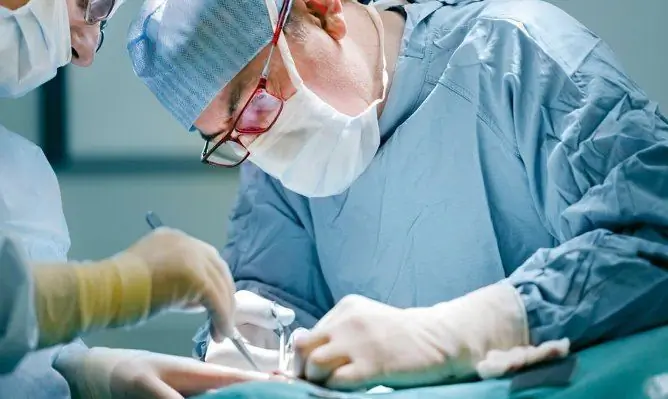- Author Rachel Wainwright [email protected].
- Public 2023-12-15 07:39.
- Last modified 2025-11-02 20:14.
Urinary incontinence

Urinary incontinence is the flow of urine that is not controlled by a person, which is detected visually.
According to statistics, urinary incontinence occurs in 14-56% of cases. But these indicators are very contradictory, since the demand for medical care for this disease is very low.
Classification of urinary incontinence
Urinary incontinence is classified as true or false.
False urinary incontinence is an involuntary flow of urine in which a person does not feel the urge to urinate. The causes of false urinary incontinence can be congenital or acquired defects of the ureter, urethra or bladder. As a rule, acquired defects result from trauma that violates the integrity of the urinary tract.
True urinary incontinence is the involuntary flow of urine that is visually observed and causes hygiene and social problems.
True urinary incontinence is divided into:
- stress incontinence that occurs with excessive exertion;
- Urgent incontinence - involuntary urination with a previous urge to urge;
- mixed incontinence - a combination of urgency and stress incontinence;
- enuresis - any uncontrolled loss of urine;
- Bed-wetting;
- persistent enuresis;
- situational urinary incontinence (with strong laughter or intercourse).
The causes of true urinary incontinence can be many factors. This symptom is observed in spinal cord injuries, advanced cystitis, spinal hernia, complicated bladder contraction.
Stress urinary incontinence is caused by a weakening of the bladder sphincters and a weak pelvic floor muscle tone. In men, urinary incontinence often occurs after surgery on the bladder neck, seminal tubercle or prostate gland. In women during menopause, the cause of urinary incontinence is a dysfunction of the closure apparatus of the bladder or a violation of detrusor tone due to estrogen deficiency.
The main causes of urinary incontinence are:
- advanced age;
- estrogen deficiency in women during menopause;
- circulatory disorders;
- bladder outlet obstruction;
- sensory impairment;
- the effect of serotonin and prostaglandins;
- anatomical changes in the position of the bladder and urethra;
- myogenic disorders.
Bedwetting occurs mainly in children, although it also occurs in adults. The most common cause of bedwetting is fright or severe trauma.
Diagnosis of urinary incontinence
A certain difficulty in the diagnosis of urinary incontinence is presented by various ectopias of the ureteral orifice. As a rule, an ectopic orifice is determined by instrumental examination (examination of the vagina through a speculum, urethrocystoscopy, rectoscopy). Sometimes it is advisable to use an indigo carmine test to identify the cause of urinary incontinence. For this, a solution of indigo carmine 0.4% in an amount of 5 ml is injected intravenously and it is observed how it will be excreted along with urine from the ectopic mouth.
Also, in the diagnosis of urinary incontinence, the following methods are used:
- Examination on a gynecological chair. Using this diagnostic method, you can determine the presence and degree of prolapse of the walls of the vagina, cystocele, uterus.
- A cough test that provides visual evidence of stress urinary incontinence.
- Layer test.
- X-ray examination methods such as urethrocystography. With the help of these methods, it is possible to determine the shape of the bladder, the position of its neck and the dynamics of changes under tension and at rest.
- Ultrasound diagnostic methods. Correctly performed perineal ultrasound provides the same information as urethrocystography, only the patient is not exposed to radiation exposure.
To select an adequate treatment for urinary incontinence, the basis is the urodynamic examination of the patient, supplemented by a urination diary. Urodynamic research is carried out to determine the parameters of the evacuation and storage functions of the bladder.
Recently, the MRI method has become widespread when examining women with stress urinary incontinence.
Treatment of urinary incontinence

Depending on the cause of the disease, treatment for urinary incontinence can be:
- conservative;
- surgical (surgery for urinary incontinence).
Conservative methods are indicated for patients with mild stress incontinence, urgent incontinence caused by overactive urethra or detrusor. Treatment of stress urinary incontinence has two directions: inhibition of detrusor activity and an increase in the tone of the closure apparatus of the bladder.
It is believed that urgency and stress urinary incontinence in women during menopause is a consequence of a lack of estrogen, so they are prescribed estrogen-containing drugs. As a rule, this leads to rather positive results.
With conservative treatment of urinary incontinence, the doctor normalizes the patient's diet, increases his physical activity. The traditional treatment of urinary incontinence should primarily include physiotherapy exercises. It helps to improve the blood supply to the pelvic organs, increases the compensatory function of the respiratory and cardiovascular systems, strengthens the musculo-ligamentous apparatus and helps to normalize the mental state of patients.
For mild incontinence, traditional treatments for urinary incontinence such as pessaries can help. They, of course, do not eliminate the cause of the disease, but they can help the patient avoid embarrassment. It should be noted that the patient is significantly uncomfortable with the need to remove the pessary before urination and its subsequent establishment. In addition, some patients note that pressure sores may appear when using a pessary.
A positive effect in the treatment of urinary incontinence is observed after electrical stimulation of the tissues and organs of the pelvis. And with a mild degree of urinary incontinence, some patients have noted the positive effect of acupuncture.
Minimally invasive surgeries for urinary incontinence include injection treatment in women with severe prolapse of the bladder and vaginal walls, as well as with neurogenic urinary disorders. When carrying out injection therapy, Teflon paste, collagen, homogenized auto fat and other substances are used.
It should also be noted transvaginal surgery for urinary incontinence of types 1-2 - urethrocervicopexy. Recently, loop or sling operations for urinary incontinence have become widespread. A flap from the anterior wall of the vagina, a musculo-aponeurotic flap, a skin flap, or synthetic materials are used as a free loop. The final result of surgical treatment can be judged after at least three years after the intervention.
YouTube video related to the article:
The information is generalized and provided for informational purposes only. At the first sign of illness, see your doctor. Self-medication is hazardous to health!






